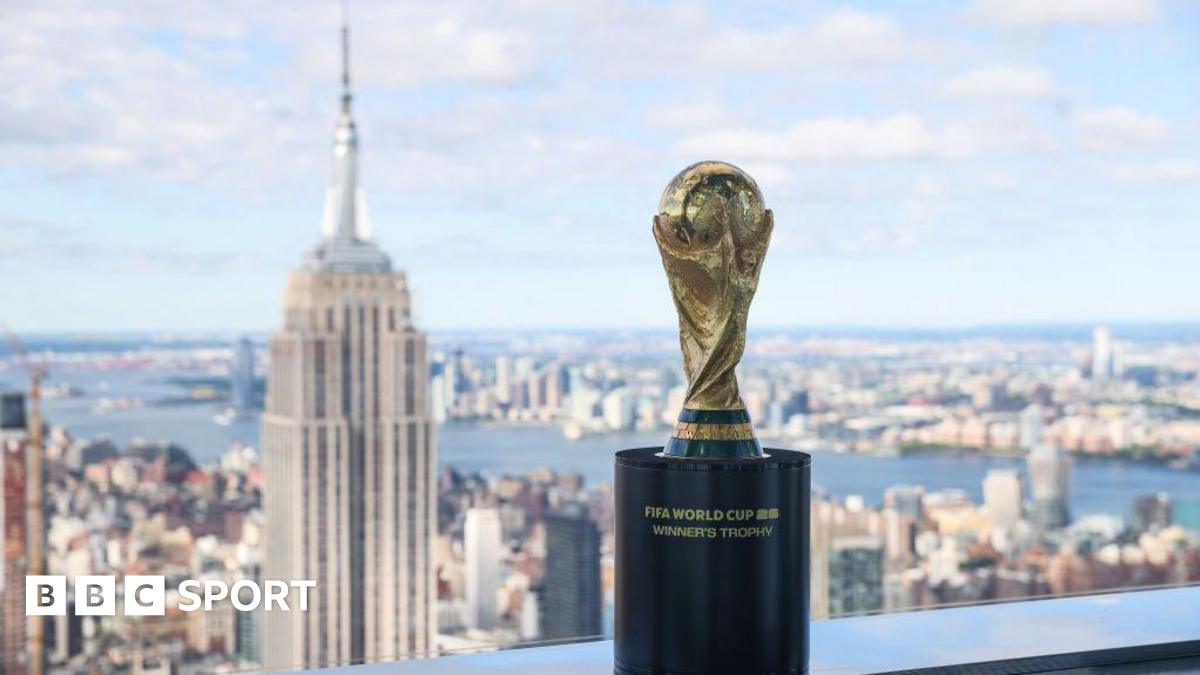
The 2026 World Cup will he held across North America
European teams will discover their 2026 World Cup qualifying opponents in Friday’s draw, which will be held at 11:00 GMT in Zurich.
A total of 16 Uefa teams will qualify for the expanded 48-team tournament to be held in the United States, Canada and Mexico.
You can watch the draw live on the BBC Sport website – along with live text commentary – and on the iPlayer.
So how does it work – and who could the home nations face?
The format for European qualifying has changed, with more groups – and smaller ones than before.
There will be 12 World Cup qualifying groups. Six will have four teams and six will have five teams.
Teams will play each other home and away as usual.
The top team from each group qualifies automatically for the World Cup, with the runners-up going into the play-offs with four Nations League teams.
Four of the 16 play-off teams will qualify for the tournament.
All of the groups will contain one team each from pots one to four. Six of the groups will also have a team from pot five. There are some restrictions on which teams can be drawn in which groups, and who they can face – more on that below.
The teams will be drawn in order of pots – so pot one teams first, then pot two and so on.
Pot 1: Spain, Germany, Portugal, France, Italy, Netherlands, Denmark, Croatia, ENGLAND, Belgium, Switzerland, Austria
Pot 2: Ukraine, Sweden, Turkey, WALES, Hungary, Serbia, Poland, Greece, Romania, Slovakia, Czech Republic, Norway
Pot 3: SCOTLAND, Slovenia, Republic of Ireland, Albania, North Macedonia, Georgia, Finland, Iceland, NORTHERN IRELAND, Montenegro, Bosnia-Herzegovina, Israel
Pot 4: Bulgaria, Luxembourg, Kosovo, Belarus, Armenia, Kazakhstan, Azerbaijan, Estonia, Cyprus, Faroe Islands, Latvia, Lithuania
Pot 5: Moldova, Malta, Andorra, Gibraltar, Liechtenstein, San Marino
The four teams who win the Nations League quarter-finals in March must each go into one of the four-team World Cup qualifying groups (Groups A-F).
That is because the Nations League finals are played in June, leaving less room in the calendar for World Cup qualifiers.
Because this draw takes place before those games, the quarter-finalists will be drawn as placeholders. For example, the winner of France v Croatia will go in one group, with the loser going in another.
A maximum of one losing Nations League quarter-finalist or one Nations League promotion-relegation play-off team can go in one group.
Scotland and the Republic of Ireland are among the 16 teams in those play-offs – so are more than likely to end in a four-team group.
England are likely to be in a five-team group.
The bottom six seeded teams will automatically go into Groups G-L.
For political reasons, Ukraine and Belarus cannot be in the same group, and neither can Gibraltar and Spain. Kosovo must be kept apart from Serbia and Bosnia-Herzegovina.
Weather is a factor too. Because of the potential cold conditions, a maximum of two of Estonia, the Faroe Islands, Finland, Iceland, Latvia, Lithuania and Norway can be drawn together. Iceland and the Faroes cannot be drawn together as they are considered the two countries most at risk of weather disruptions.
There are also geographical limits on who Kazakhstan, Azerbaijan and Iceland can face to avoid too many trips to the opposite side of Europe.
The games will be held over 10 matchdays during five international breaks.
Those international breaks are 21-25 March, 6-10 June, 4-9 September, 9-14 October and 13-18 November.
However no team will play World Cup qualifiers on all of those dates because there is a maximum of eight games.
Some teams will start in March, others will start in June and four-team groups will not start until September.
The play-offs will be 26-31 March 2026.
The World Cup will start on 11 June in Mexico City and end on 19 July in New Jersey.
The expanded 48-team tournament will last a record 39 days.
The new format will feature 12 four-team groups and a last-32 knockout round for the first time.
Listen to the latest Football Daily podcast
Get football news sent straight to your phone
Premier League: Man City, Bournemouth, Villa and Brentford win as Palace draw with Chelsea
Isak scores again as Newcastle beat Spurs to extend winning run
Rickelton hits 259 as SA take control against Pakistan
Strike and Robin tackle their latest thrilling case
Tom Burke and Holliday Grainger star in another masterful Robert Galbraith mystery
Lily and Miquita discuss their resolutions for 2025
Join lifelong friends twice a week for their transatlantic catch-ups
Revisit the classic, acclaimed series
Beloved sitcom about a working-class family, whose lives revolve around the TV
The astonishing double life of a secret agent
Trace Stakeknife's story, an agent who walked the tightrope between the IRA and British Army intelligence
Teenage kicks – what makes history-making Littler so good?
Cummins ends electric innings by India's Pant. Video
Postecoglou has 'no problem' with Maddison at darts
'Like a cat toying with a mouse' – but Littler's victory was far from inevitable
US Olympic sprinter Kerley tasered after police confrontation
Bumrah takes final-ball wicket after altercation. Video
Who has made Troy's Premier League team of the week?
'Real Rangers stand up, but can they keep standing?'
Watch best of action as Rangers beat Celtic in derby. Video
What shape are Lionesses in for 2025?
Watch the goals as Dundee Utd strike late to win derby. Video
Sporting highlights to look forward to in 2025
The 'genius' behind 'one of best images' in tennis
What's the latest on Alexander-Arnold, and others who might move?
What challenges lie ahead for Tuchel?
'Humble & popular but no plan B' – The inside story of Rooney at Plymouth
How Ferguson masterminded Aberdeen's greatest win
The best sports photos of 2024 – and how they were captured
© 2025 BBC. The BBC is not responsible for the content of external sites. Read about our approach to external linking.

